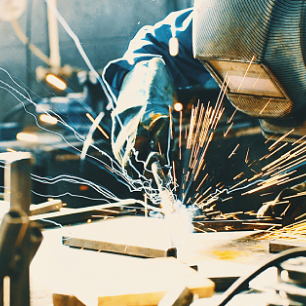Jump to:
Understanding Aluminum Storage and Preparation
As many welders can attest, welding aluminum is a different ball game than welding steel. With its low melting point but high thermal conductivity, aluminum can go from solid to liquid very quickly, catching both beginners and seasoned welders off guard during the welding process. Practice definitely helps when welding aluminum, but proper material prep and equipment can significantly ease that steep learning curve.
Familiarizing Yourself with Aluminum’s Differences
For welders who are used to handling steel, aluminum can accurately be described as a material that’s the complete opposite. It’s lighter and softer and has a lower melting point (approximately 1200°F), which means that once it heats up, it can stay hot and easily lead to burn-through. It also requires 100% argon (or an argon/helium mix) for arc stability — another significant departure from what’s used for steel.
As a result, high-quality welds are far more difficult to achieve on aluminum. While the metal is mechanically different, another unique aspect of aluminum is that it develops a tough oxide surface film, which can lead to quality issues such as porosity and incomplete fusion or penetration, all of which can compromise weld quality. The oxide layer melts at a much higher temperature than the base aluminum (approximately 3700°F), so operators either need to set the welding parameters to break the oxidation, creating a hotter pool to burn through that layer, or, preferably, clean and prepare the base metal prior to welding.
Cleaning Aluminum Is Critical
Oxide prevention is key to minimizing how thick it forms on the metal. The most important thing to remember when handling aluminum is to keep it as dry as possible. An excessive presence of moisture will contribute to an increasing thickness of the oxide. One way to mitigate this issue is by storing metal vertically, which allows water to run off, reduces the risk of condensation, and promotes airflow. Additionally, leaving gaps between stock materials helps further improve ventilation and minimize moisture retention. Typically, more humid states are at a disadvantage when handling aluminum, making proper storage even more important.
The most common approaches to preparing aluminum involve using stainless steel brushes, aluminum-specific grinding discs, or an aluminum-specific chemical cleaner to remove the buildup. Oxides can re-form quickly when exposed to oxygen, so the workpiece should always be cleaned right before welding occurs.
The level of cleanliness and metal preparation required for welding directly correlates with the desired weld quality. In critical industries such as military, aerospace, and naval applications, these factors are closely monitored to ensure compliance with stringent standards and performance requirements. Suitable preparation before welding is especially important when fabrications must meet stricter weld quality requirements of manufacturing codes, such as AWS D1.2, Structural Welding Code — Aluminum, the code for aluminum that provides the blueprint for welds in structural applications. The more prescriptive the requirements are, the more time and prep should go into cleaning the workpiece.
Proper Filler Metal Selection and Handling Promote High-Quality Welds
As with any welding, the filler metal chosen needs to meet the characteristics of the base metal and its intended application. For aluminum applications, 4043, 4943, and 5356 are used in over 85% of all aluminum weldments. 4043 is a popular aluminum/silicon filler alloy for general-purpose welding applications. The added silicon lowers the melting point and improves fluidity, reducing the risk of hot cracking, and provides smooth and consistent welding performance.
4943 is a heat-treatable, high-strength aluminum filler metal that offers the welding ease and advantages of 4043. Unlike other alloys, it does not rely on base metal dilution to enhance weld deposit strength. Additionally, 4943 welds produce minimal smut and distortion, ensuring cleaner, more precise results.
5356 takes everything up a level. It’s preferred for anodized color matching, provides better feedability through the welding gun (twice as stiff as 4043 and 4943), and has higher strength, ductility, and toughness.
Selecting the right filler metal is likely pretty easy, but maintaining its integrity is key. The most important aspect of aluminum filler metal storage and prep is that moisture must not be allowed to come into contact with the product or packaging because it can significantly affect product performance. Sources of moisture include dripping water, condensation, and excessive humidity.
Wires should be stored in a dry, enclosed environment and, preferably, at a constant temperature with minimal fluctuations to prevent them from cycling through dew points. If the filler metal is moved from colder to warmer environments, it must be allowed to stabilize thermally in the welding environment for at least 24 hours prior to welding. If not acclimated, condensation can form directly on the wire, creating hydrated oxide on exposed surfaces and causing weld discontinuities. To assist customers in navigating this potential issue, dew point charts are available to help determine when condensation may form on filler metal (see Table 1). If the filler metal temperature falls below the dew point, as indicated by the intersection of the welding environment’s air temperature and relative humidity, condensation will occur. This can lead to weld discontinuities and quality issues. Proper storage and handling are essential to prevent moisture-related defects.
Other Considerations for Aluminum Welding
While not strictly required, a push-pull welding gun is recommended for aluminum welding because of aluminum filler metal’s low columnar strength. The wire is unable to resist buckling or bending when force is applied, and this intolerance to being pushed, especially over longer distances, easily causes tangling or bird nesting inside a standard wire feeder. A push-pull gun mitigates this issue because it feeds the wire from both ends (one motor at the spool and one at the gun), ensuring a smoother, more consistent feeding. The push-pull system also enables longer cable lengths without wire feeding problems, whereas standard gas metal arc guns would struggle to feed aluminum wire over long distances.
A push-pull gun mitigates many feeding issues, but keeping an eye on drive roll tension is also important. The driver tension should be between 1 and 2 to help ensure the wire isn’t restricted. Otherwise, the wire can be inhibited from twisting naturally as it’s going through the system. When that happens, the wire will slowly work its way back to the drum and knot up, creating a time-consuming problem to fix.
The wire pathway is just as important. Whether using 0.035- or 1/16-in. wire, smooth feedability depends on a clean, debris-free liner and a torch cable kept as straight as possible to minimize resistance. Additionally, inlet guides at the back of the feeder and between the drive rolls must be properly aligned and nonmetallic. With drum packaging delivery systems, attention to the conduit pathway is even more critical. Longer, winding paths from the drum to the feeder increase resistance and restrict the twist in the wire from exiting the system. To ensure smoother feeding and reduce potential issues, it’s essential to minimize 90-deg turns and keep the pathway as straight as possible.
Unlike steel, where certain welding fundamentals can sometimes be overlooked without major issues, aluminum welding demands precision. Successful welds depend on proper drive roll tension, a clean and debris-free liner trimmed to the correct length, a properly adjusted spool brake, and a contact tip free from excessive keyholing, along with maintaining cleanliness in the feeder and base material.
Ending Thoughts
Welding aluminum can be complex, but with the right base knowledge, preparation, and equipment, it becomes much more manageable to navigate the challenges effectively.
This article was written by Seth Perrin (product manager for mild steel and aluminum solid wire at Hobart Brothers LLC) for the American Welding Society.


